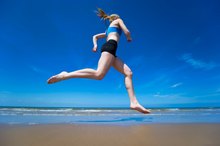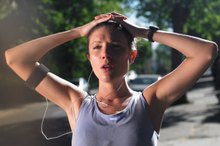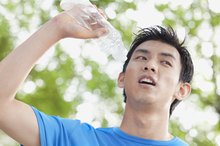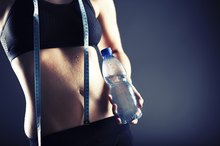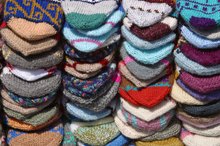What does fact checked mean?
At Healthfully, we strive to deliver objective content that is accurate and up-to-date. Our team periodically reviews articles in order to ensure content quality. The sources cited below consist of evidence from peer-reviewed journals, prominent medical organizations, academic associations, and government data.
The information contained on this site is for informational purposes only, and should not be used as a substitute for the advice of a professional health care provider. Please check with the appropriate physician regarding health questions and concerns. Although we strive to deliver accurate and up-to-date information, no guarantee to that effect is made.
Exercise Sweating Leading to a Rash Under Breasts
Rashes are a common skin symptom, especially in moist, dark areas such as under the breast. Most rashes go away within a day or two of using home care measures, although some rashes persist, depending on the cause. Fortunately, most rashes under your breast that occur after sweating during exercise are treatable and preventable with proper self-care measures and changes to your workout habits 2.
Environmental Causes
Exercising in hot weather often leads to a skin rashes, especially on parts of your body that are covered with clothing and where sweat is not able to evaporate. If your workout clothes are new, chemicals used in their manufacturing irritate the sensitive skin under your breasts, leading to a rash. A sports bra that is too tight produces friction against your skin while you exercise, producing a rash where the bra rubbed against your skin. Use of a new detergent or skin care product is another cause of rashes on your skin.
- Exercising in hot weather often leads to a skin rashes, especially on parts of your body that are covered with clothing and where sweat is not able to evaporate.
- A sports bra that is too tight produces friction against your skin while you exercise, producing a rash where the bra rubbed against your skin.
Medical Causes
Rash From Exercising the Outer Thighs
Learn More
Skin conditions such as eczema, dermatitis, and hives from allergic reactions are common causes of skin rashes. If you work out regularly and wear tight fitting clothing made of polyester, spandex or other man-made materials, sweat that accumulates under your breasts promotes the growth of yeast on your skin, resulting in candidiasis. Although most rashes around your breast result from the same causes as rashes on the rest of your body, certain breast diseases also cause rashes, usually just on one breast. A breast abscess or mastitis, common among lactating women, causes a red, streaked rash on your skin. Other serious breast diseases including inflammatory breast cancer, mammary duct ectasia and Paget’s disease of the breast also cause rashes.
- Skin conditions such as eczema, dermatitis, and hives from allergic reactions are common causes of skin rashes.
- A breast abscess or mastitis, common among lactating women, causes a red, streaked rash on your skin.
Treatments
Take a warm shower after you exercise, taking care to gently cleanse the area under your breasts. Avoid hot water and rough scrubbing, as these can further irritate your skin, worsening the rash and making it itch. Apply hydrocortisone cream to your skin if your rash itches. If the rash on your breast does not go away within a few days of performing self care treatments, see your doctor. Your doctor will perform a breast exam and, if necessary, conduct imaging studies such as x-ray or magnetic resonance imaging (MRI) to determine a course of medical treatment for your rash.
- Take a warm shower after you exercise, taking care to gently cleanse the area under your breasts.
- Apply hydrocortisone cream to your skin if your rash itches.
Prevention
White Dots on Skin When Exercising
Learn More
Washing new workout clothes helps remove any chemical additives that could irritate your skin. Using free and clear detergents on your clothing and vinegar in your washing machine as a fabric softener rather than chemical fabric softener sheets also helps prevent skin irritations from fabric. Wear properly fitting bras to avoid friction against your skin. After working out, showering and thoroughly drying off helps remove sweat and moisture from your skin, reducing the risk of some skin rashes. Exercising indoors on hot days or early in the morning before the heat builds up helps prevent heat-related skin rashes.
- Washing new workout clothes helps remove any chemical additives that could irritate your skin.
- Using free and clear detergents on your clothing and vinegar in your washing machine as a fabric softener rather than chemical fabric softener sheets also helps prevent skin irritations from fabric.
Related Articles
References
- The Merck Manual Home Health Handbook: Itching and Noninfectous Rashes
- FamilyDoctor.org: Skin Rashes and Other Changes
- University of Maryland Medical Center: Candidiasis
- Laas E, Touboul C, Kerdraon O, Catteau-jonard S. [Inflammatory and infectious breast mastitis outside of pregnancy and lactation: Guidelines]. J Gynecol Obstet Biol Reprod (Paris). 2015;44(10):996-1016. doi:10.1016/j.jgyn.2015.09.055
- National Institute of Health. Eczema (Atopic Dermatitis).
- National Institutes of Health. Psoriasis Types.
- National Cancer Institute. Inflammatory Breast Cancer.
- National Cancer Institute. Paget’s Disease of the Breast.
- Kontoes P, Gounnaris G. Complications of Fat Transfer for Breast Augmentation. Aesthetic Plast Surg. 2017 Oct;41(5):1078-1082. doi: 10.1007/s00266-017-0911-2. Epub 2017 Jun 22.
Resources
Writer Bio
Jessica Lietz has been writing about health-related topics since 2009. She has several years of experience in genetics research, survey design, analysis and epidemiology, working on both infectious and chronic diseases. Lietz holds a Master of Public Health in epidemiology from The Ohio State University.


